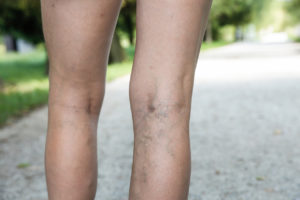Vein Disease
What Causes Vein Disease?
Venous insufficiency occurs when a valve fails to function as designed. Sometimes the valves become damaged or diseased causing blood to flow backwards (reflux) or causing blood to pool in your legs (stasis). This condition can lead to very painful and discomforting symptoms such as pain, aching, throbbing, fatigue, skin changes, lesions, heaviness, itching/cramping and varicose veins. If vein disease is left untreated, symptoms can worsen and lead to chronic venous insufficiency. According to the ACP, over 40 million Americans both men and women, will develop a form of vein disease at one point in their lives. Vascular conditions affect the veins and arteries in your body, which conduct oxygen to every living cell. Veins and arteries are like highways. When there is a road block or traffic jam, trouble ensues. In most cases, vascular conditions are treatable, often without surgery.
Early symptoms may seem minor. However, if left untreated they can become more serious and even life threatening. It is important to be aware of symptoms and seek medical advice at the earliest sign of a problem.
Chronic Venous Insufficiency
Venous insufficiency is a catch-all phrase applied to a number of disorders that affect the veins and valves in the veins. These disorders interfere with blood flow, causing pools and leading to a variety of symptoms including spider veins, varicose veins, and other changes in the skin. There are several symptoms to look out for and can include:
- Edema
- Heaviness

- Pain or cramps in the legs
- Restlessness
- Dermatitis
- Spider veins and varicose veins
- Venous leg ulcer
If you think you may have a venous insufficiency condition call us today to schedule a consultation.
